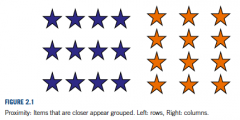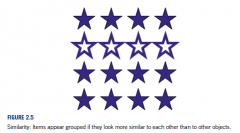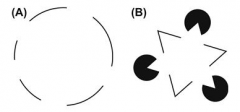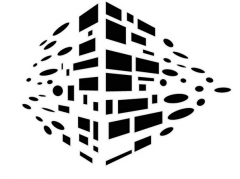![]()
![]()
![]()
Use LEFT and RIGHT arrow keys to navigate between flashcards;
Use UP and DOWN arrow keys to flip the card;
H to show hint;
A reads text to speech;
70 Cards in this Set
- Front
- Back
|
Fovea |
pit near center of eye packed with cones |
|
|
Rods |
very sensitive to light and are mostly responsible for night vision; concentrated in peripheral vision |
|
|
Cones |
colour sensitive; concentrated in center of retina |
|
|
S-cones... M-cones... L-cones... |
...detect blue ...detect green ...detect red |
|
|
What pathway (ventral) |
pathway of neural processing in the brain that is responsible for your ability to recognize what’s around you |
|
|
Where-and-how pathway (dorsal) |
pathway of neural processing in the brain that is responsible for you knowing where things are in the world and how to interact with them |
|
|
Primary visual cortex |
brain region located in occipital cortex (back of head) responsiblefor processing basic visual info like the detection, thickness, and orientation of simple lines,color, and small-scale motion |
|
|
Why do we have two eyes? What is binocular advantage? |
allows us to see same scene twice; our brains combine the 2D signals from both eyes into a “3D” image to create depth perception |
|
|
Contrast gain |
process where sensitivity of vision system can be tuned to be most sensitive to the levels of contrast most prevalent in an environment |
|
|
Dark adaptation |
process where you become sensitive to very small levels of light, so you can see even in its near-absence |
|
|
Lateral inhibition |
a signal produced by a neuron aimed at suppressing the response of nearby neurons |
|
|
Opponent process theory |
theory of color vision that assumes there are 4 basic colors organized in pairs (red/green, blue/yellow) and proposes colors in the world are encoded in terms of the difference between the colors in each pair. A black/white pair is responsible for coding light contrast |
|
|
Photoactivism |
a photochemical reaction that occurs when light hits photoreceptors in the retina, producing a neural signal |
|
|
Synesthesia |
blending of two or more sensory experiences |
|
|
Trichromacy theory |
theory that proposes all your colour perception is fundamentally based on the combination of three different colour signals |
|
|
Vestibulo-ocular reflex |
coordination of motion info with visual info that allows you to maintain your gaze on an object while moving your head |
|
|
Gestalt principle of proximity |

objects near each other (relative to other objects) appear grouped, while others do not |
|
|
Gestalt principle of similarity |

objects that look similar appear grouped |
|
|
Gestalt principle ofcontinuity |

our visual perception is biased to perceive continuous forms rather than disconnected segments |
|
|
Gestalt principle ofclosure |

our visual system automatically tries to close open figures so that they are perceived as whole objects rather than separate pieces |
|
|
Gestalt principle of symmetry |

we tend to parse complex scenes in a way that reduces the complexity. The data in our visual field usually has more than one possible interpretation, but our vision automatically organizes and interprets the data so as to simplify it and give it symmetry |
|
|
Gestalt principle of figure/ground |

our mind separates the visual field into the figure (the foreground) and ground (the background). The foreground consists of the elements of a scene that are the object of our primary attention, and the background is everything else |
|
|
Gestalt principle of common fate |

related to the Proximity and Similarity principles—like them, it affects whether we perceive objects as grouped. The Common Fate principle states that objects that move together are perceived as grouped or related |
|
|
Priming |
preparing our brain to perceive something in a certain way |
|
|
Frames |
include objects or events that are usually encountered in a familiar situation. Bias our perception of events and places because of what we expect to see. Applies to technology too (e.g. position of “back” and “next” buttons) |
|
|
Habituation |
repeated exposure to the same (or highly similar) perceptions dulls ourperceptual system’s sensitivity to them |
|
|
Attentional blink |
just after we spot or hear something important, for a very brief periodfollowing the recognition—between 0.15 and 0.45 second—we are nearly deaf and blindto other visual stimuli, despite our other sense still working |
|
|
Optical illusion |
trick us because our visual system does not use accurate, optimal methods to perceive the world due to evolution (i.e. our perception is full of “bugs”) |
|
|
Muller-Lyer illusion |

two horizontal lines are the same length, but the outward-pointing “fins” cause our visual system to see the top line as longer than the line with inward-pointing “fins.” |
|
|
McGurk effect |
watch a video of someone saying “bah, bah, bah,” then “dah, dah, dah,”then “vah, vah, vah,” but the audio is “bah, bah, bah” throughout, you will hear the syllableindicated by the speaker’s lip movement rather than the syllable actually in the audio track |
|
|
How do goals bias our perception? |
they guide our perceptions so we sample what we need from the world, and filter things that aren’t related to our goals out of our perceptions |
|
|
Cocktail-party effect |
if you are conversing with someone at a crowded party, you can focus your attention to hear mainly what he or she is saying even though many other people are talking near you. The more interested you are in the conversation, the morestrongly your brain filters out surrounding chatter |
|
|
What are three implications of our perceptual biases? How can be apply them? |
1. avoid ambiguity 2. be consistent 3. understand the goals |
|
|
What are three essential elements of science? |
1. science consists of systematic observation 2. science is democratic 3. science is cumulative |
|
|
What are five ethical guidelines for psychological research and what do they entail? |
Informed consent. Participants should know they are involved in research and have a choice whether or not to participate Confidentiality. Findings about an individuality are kept private unless participant’s consent is given Privacy. Researchers will not seek out private information without consent Benefits. Researchers and participants should understand the risks and rewards of the research, and participants should only be exposed to risks if they understand them and if the benefits outweigh those risks Deception. Researchers must debrief their participants after they have completed the study, so they understand the true nature of the research |
|
|
Empirical methods |
approaches to inquiry that are tied to actual measurement andobservation |
|
|
Ethics |
professional guidelines that offer researchers a template for making decisions that protect research participants from potential harm and that help steer scientists away from conflicts of interest or other situations that might compromise the integrity of their research |
|
|
Hypothesis |
a logical idea that can be tested |
|
|
Systematic observation |
the careful observation of the natural world with the aim of better understanding it. Observations provide the basic data that allow scientists to track, tally, or otherwise organize information about the natural world |
|
|
Theories |
groups of closely related phenomena or observations |
|
|
Empiricism |
branch of psychology in which it is believed that“knowledge comes from experience” |
|
|
Structuralism |
branch of psychologyinterested in contents of the mind and what it is |
|
|
Functionalism |
branch of psychology nterested in activities of the mind and what it does |
|
|
Gestalt |
whole of any experience is richer than studying the individual parts; “the whole is greater than the sum of its parts”; unity |
|
|
Behaviorism |
branch of psychology that deems overt and observable behavior the proper subject of psychology |
|
|
Cognitive psychology |
branch of psychology interested in the study of mental processes |
|
|
Eugenics |
practice of selective breeding to promote desired traits |
|
|
Flashbulb memory |
highly detailed and vivid memory of an emotionally significant event |
|
|
Individual differences |
ways people differ in terms of behavior, emotion, cognition, development |
|
|
Design as a reflective practice (D. Schon) |
believes designers should use science to inform their designs |
|
|
Science of the artificial (H. Simon) |
uses structured design methods that will improve some situation; designer must insure that a design works in any likely set of external conditions andsituations |
|
|
Means-end analysis |
compares a design relative to the goals for the thing designed |
|
|
Satisficing |
happens when a decision is “good enough” to implement into a design |
|
|
Technology as a special case (W. Brian Arthur) |
at a minimum, technology harnesses some phenomenon to achieve an objective. Also... 1. tech provides some capability based on the principle of X 2. small technologies combine 3. tech designers learn language of capabilities |
|
|
Theory of natural science (the scientific method) |
scientists should make bold predictions in testable hypothesis; experiments should be designed to falsify those predictions |
|
|
Theory of design evaluation |
“design is a hypothesis” - if I do X users will do Y; the designer is predicting user behavior |
|
|
Conceptual models |
describe a phenomenon metaphorically |
|
|
Computational models |
computers program that makes predictions based on algorithm |
|
|
Computational theories |
computer program in which the algorithm must simulate real-world causal relationships |
|
|
SOAR (Newell) |
computational theory that uses mechanisms of “chunking” and procedural learning, means-end analysis |
|
|
ACT-R (Anderson) |
computational theory thatattempts to build subprograms for each aspect of the structure of mental processing that experimental psychologists discover |
|
|
Divided attention |
the ability to flexibly allocate attentional resources between two or more concurrent tasks |
|
|
Selective attention |
the ability to select certain stimuli in the environment to process, while ignoring distracting information |
|
|
Dichotic listening |
an experimental task in which two messages are presented to different ears of a subject, and they are required to repeat only the syllables spoken in their left ear |
|
|
Inattentional blindness |
the failure to notice a fully visible object when attention is devoted to something else |
|
|
Limited capacity |
the notion that humans have limited mental resources that can be used at agiven time |
|
|
Shadowing |
a task in which the individual is asked to repeat an auditory message as it is presented |
|
|
Subliminal perception |
the ability to process information for meaning when the individual is notconsciously aware of that information |
|
|
Inattentional deafness |
the auditory analog of inattentional blindness. People fail to notice anunexpected sound or voice when attention is devoted to other aspects of a |
|
|
Selective listening |
a method for studying selective attention in which people focus attention on one auditory stream of information while deliberately ignoring other auditory information. |

